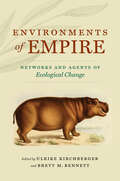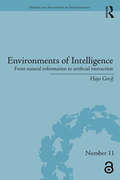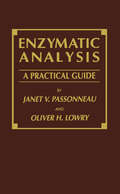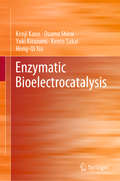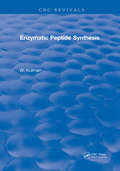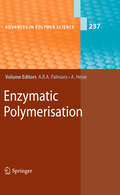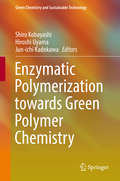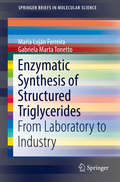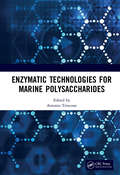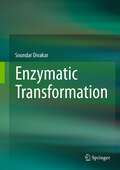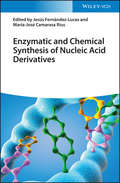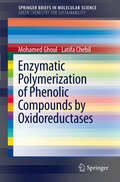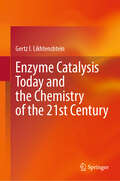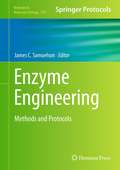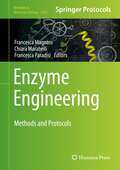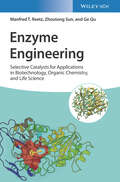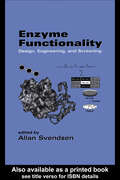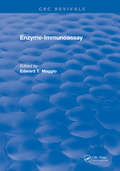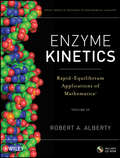- Table View
- List View
Environments and Survival: Snails, Robots, and Biomimicry
by The Lawrence Hall of ScienceNIMAC-sourced textbook
Environments and Survival: Snails, Robots, and Biomimicry, Investigation Notebook (Amplify Science)
by The Lawrence Hall of ScienceNIMAC-sourced textbook
Environments of Empire: Networks and Agents of Ecological Change (Flows, Migrations, and Exchanges)
by Ulrike Kirchberger and Brett M. BennettThe age of European high imperialism was characterized by the movement of plants and animals on a historically unprecedented scale. The human migrants who colonized territories around the world brought a variety of other species with them, from the crops and livestock they hoped to propagate, to the parasites, invasive plants, and pests they carried unawares, producing a host of unintended consequences that reshaped landscapes around the world. While the majority of histories about the dynamics of these transfers have concentrated on the British Empire, these nine case studies--focused on the Ottoman, French, Dutch, German, and British empires--seek to advance a historical analysis that is comparative, transnational, and interdisciplinary to understand the causes, consequences, and networks of biological exchange and ecological change resulting from imperialism. Contributors: Brett M. Bennett, Semih Celik, Nicole Chalmer, Jodi Frawley, Ulrike Kirchberger, Carey McCormack, Idir Ouahes, Florian Wagner, Samuel Eleazar Wendt, Alexander van Wickeren, Stephanie Zehnle
Environments of Intelligence: From natural information to artificial interaction (History and Philosophy of Technoscience)
by Hajo GreifWhat is the role of the environment, and of the information it provides, in cognition? More specifically, may there be a role for certain artefacts to play in this context? These are questions that motivate "4E" theories of cognition (as being embodied, embedded, extended, enactive). In his take on that family of views, Hajo Greif first defends and refines a concept of information as primarily natural, environmentally embedded in character, which had been eclipsed by information-processing views of cognition. He continues with an inquiry into the cognitive bearing of some artefacts that are sometimes referred to as 'intelligent environments'. Without necessarily having much to do with Artificial Intelligence, such artefacts may ultimately modify our informational environments. With respect to human cognition, the most notable effect of digital computers is not that they might be able, or become able, to think but that they alter the way we perceive, think and act. The Open Access version of this book, available at http://www.tandfebooks.com/doi/view/10.4324/9781315401867, has been made available under a Creative Commons CC-BY licence
Environments: FOSS Science Stories
by University of California at Berkeley Lawrence Hall of ScienceNIMAC-sourced textbook
Envy And Gratitude And Other Works 1946-1963: A Study Of Unconscious Sources
by Melanie KleinA perfect introduction to Melanie Klein’s modern neuroscientific research. Melanie Klein's writings, particularly on infant development and psychosis, have been crucial both to theoretical work and to clinical practice. Envy and Gratitude collects her writings from 1946 until her death in 1960, including two papers published posthumously. Klein's major paper, 'Notes on Some Schizoid Mechanisms', introduces the concept of the paranoid-schizoid position, in which the infant ego splits, projects and introjects its objects - most particularly the mother - during the first few months of life. Envy and Gratitude, her last major work, introduces her theory of primary envy.
Enzymatic Analysis
by Oliver H. Lowry Janet V. PassonneauThis new edition of a classic laboratory manual covers the general principles, specific methods and procedures, and quantitative histochemistry of enzymatic analysis. It presents a systematic scheme for analyzing biological materials and explains the theory and techniques in terms simple enough for anyone to follow. The protocols are written in a clear, easy to follow style as if the author had just performed the technique himself and knows exactly the problems to be encountered.
Enzymatic Bioelectrocatalysis (Springerbriefs In Molecular Science Ser.)
by Kenji Kano Osamu Shirai Yuki Kitazumi Kento Sakai Hong-Qi XiaThis book covers the fundamental aspects of the electrochemistry and redox enzymes that underlie enzymatic bioelectrocatalysis, in which a redox enzyme reaction is coupled with an electrode reaction. Described here are the basic concept and theoretical aspects of bioelectrocatalysis and the various experimental techniques and materials used to study and characterize related problems. Also included are the various applications of bioelectrocatalysis to bioelectrochemical devices including biosensors, biofuel cells, and bioreactors. This book is a unique source of information in the area of enzymatic bioelectrocatalysis, approaching the subject from a cross-disciplinary point of view.
Enzymatic Peptide Synthesis
by W. KullmanThis book was first published in 1987. Comprehensive overview of enzyme peptide synthesis.
Enzymatic Polymerisation
by Anja R. Palmans Andreas HeiseOxireductases in the Enzymatic Synthesis of Water-Soluble Conducting Polymers, by E. Ochoteco and D. Mecerreyes * Transferases in Polymer Chemistry, by J. van der Vlist and K. Loos * Hydrolases Part I: Enzyme Mechanism, Selectivity and Control in the Synthesis of Well-Defined Polymers, by M.A.J. Veld and A.R.A. Palmans * Hydrolases in Polymer Chemistry: Chemoenzymatic Approaches to Polymeric Materials, by A. Heise and A.R.A. Palmans * Hydrolases in Polymer Chemistry: Part III: Synthesis and Limited Surface Hydrolysis of Polyesters and Other Polymers, by G.M. Guebitz * Exploiting Biocatalysis in the Synthesis of Supramolecular Polymers, by S. Roy and R. V. Ulijn
Enzymatic Polymerization towards Green Polymer Chemistry (Green Chemistry and Sustainable Technology)
by Shiro Kobayashi Hiroshi Uyama Jun-Ichi KadokawaThis book comprehensively covers researches on enzymatic polymerization and related enzymatic approaches to produce well-defined polymers, which is valuable and promising for conducting green polymer chemistry. It consists of twelve chapters, including the following topics: <p><p> The three classes of enzymes, oxidoreductases, transferases and hydrolases, have been employed as catalysts for enzymatic polymerization and modification; <p> Well-defined polysaccharides are produced by enzymatic polymerization catalyzed by hydrolases and transferases; Hydrolase-catalyzed polycondensation and ring-opening polymerization are disclosed to produce a variety of polyesters; <p> Polyesters are synthesized by in-vivo acyltransferase catalysis produced by microorganisms; <p> Enzymatic polymerization catalyzed by appropriate enzymes also produces polypeptides and other polymers; <p> Poly(aromatic)s are obtained by enzymatic polymerization catalyzed by oxidoreductases and their model complexes; <p> Such enzymes also induce oxidative polymerization of vinyl monomers; <p> Enzymatic modification of polymers is achieved to produce functionalized polymeric materials; <p> The enzymatic polymerization is a green process with non-toxic catalysts, high catalyst efficiency, green solvents and renewable starting materials, and minimal by-products; <p> Moreover, renewable resources like biomass are potentially employed as a starting substrate, producing useful polymeric materials. <p> This book is not only educative to young polymer chemists like graduate students but also suggestive to industrial researchers, showing the importance of the future direction of polymer synthesis for maintaining a sustainable society.
Enzymatic Synthesis of Structured Triglycerides
by María Luján Ferreira Gabriela Marta TonettoThis brief presents the state of the art on enzymatic synthesis of structured triglycerides and diglycerides, focusing on glycerol as the substrate and covering interesterification of vegetable oils in one and two steps. It critically reviews the available literature on enzymatic and chemo-enzymatic synthesis of di- and triglycerides in one or more steps. The effects of the structure, length and unsaturation of the fatty acids are carefully considered, as well as the inhibitory potential of highly unsaturated complex fatty acid structures. The brief also addresses acyl migration and the use of adsorbents, taking into account the most recent literature and presenting the problem in an industrial context. It discusses experimental and analytical problems concerning, e.g. the lab scale and the scaling up to bench and pilot plants. Several examples are presented, and their successes and failures are assessed. Biocatalysts based on lipases are analyzed with regard to problems of immobilization, stability on storage time and activity after multiple uses. The need for specific Sn-2 lipases is presented and strategies for optimizing Sn-2 esterification are discussed. Lastly, practical aspects are examined, e.g. lipase “leaching” with loss of activity, taking into account the latest findings on continuous and batch reactor configurations and presenting the advantages and disadvantages of each.
Enzymatic Technologies for Marine Polysaccharides
by Antonio TrinconeThe bioactivity potential of marine polysaccharides has long been considered an underexploited aspect. These molecules found in seaweed, microalgae, bacteria, and animal fish (shellfish, mollusks, etc.) and the derived oligosaccharides need to be explored thoroughly with an interdisciplinary approach. They are an extraordinary source of chemical diversity, and the literature highlights many applicative fields, including the food industry, cosmetics, biomedicine, agriculture, environmental protection, wastewater management, etc. More recently, a new challenge has emerged: the exploitation of marine biomass as the source of sustainable energy to participate in the future replacement of fossil resources. Enzymatic Technologies for Marine Polysaccharides provides insight into the recent research developments of marine polysaccharides and their current and potential applications. The first section of the book explores the diversity of marine polysaccharides from various angles, including a description of the chemical complexity and current applications and new perspectives in food, pharmaceutical, cosmetics, and biomaterials offered by recent research. Efficient valorization of the marine polysaccharide biomass requires a rigorous analysis of the polysaccharides structure and their biological properties. The second section of the book concerns the development of extraction techniques and the improvement of the methods aimed at the characterization of their structure and function. Finally, the third and last section of the book articulates the enzymatic technologies from the discovery of novel enzymes to their production pipelines related to the fields of biorefinery, food, pharmaceutics, and other fine chemicals. Presents the latest research in marine oligosaccharides and polysaccharides Written by world-class researchers in marine enzyme technology Discusses the latest developments in extraction methods Presents a detailed overview of enzymatic routes for modification, production, and synthesis of marine oligosaccharides Contains extensive references at the end of each chapter to enhance further study
Enzymatic Transformation
by Soundar DivakarTransformations using enzymes have been extensively investigated in the last two decades and the results promise great potential for this growing field, especially in the area of synthetic organic chemistry mainly due to of its many advantages. Accordingly, this book has attempted to bring out the advantages of using enzymes involving complex underivatized and unprotected substrates in non-polar media under homogenous and heterogeneous reaction conditions. Merits and demerits of using enzymes in terms of yields and selectivity/specificity are presented without any prejudice. Almost all the reactions dealt with are from the author's laboratory comprising diverse substrates, and the catalysis involves two important hydrolyzing enzymes, extensively examined for the reverse reactions. Thus, esterification involving lipses and glycosylation involving glycosidases were investigated with respect to various strategies like optimization of reaction conditions, response surface methodology and kinetics, carrying out reactions under solvent, non-solvent and super critical carbon dioxide conditions. In short, the work presented is to ensure the comprehension of the problems faced by the researchers in this area so as to work out further efficient strategies for carrying out enzymatic transformations in the laboratory successfully with better yields and specificity.
Enzymatic and Chemical Synthesis of Nucleic Acid Derivatives
by Jesús Fernández Lucas María-José Camarasa RiusA review of innovative tools for creative nucleic acid chemists that open the door to novel probes and therapeutic agents Nucleic acids continue to gain importance as novel diagnostic and therapeutic agents. With contributions from noted scientists and scholars, Enzymatic and Chemical Synthesis of Nucleic Acid Derivatives is a practical reference that includes a wide range of approaches for the synthesis of designer nucleic acids and their derivatives. The book covers enzymatic (including chemo-enzymatic) methods, with a focus on the synthesis and incorporation of modified nucleosides. The authors also offer a review of innovative approaches for the non-enzymatic chemical synthesis of nucleic acids and their analogs and derivatives, highlighting especially challenging species. The book offers a concise review of the methods that prepare novel and heavily modified polynucleotides in sufficient amount and purity for most clinical and research applications. This important book: -Presents a timely and topical guide to the synthesis of designer nucleic acids and their derivatives -Addresses the growing market for nucleotide-derived pharmaceuticals used as anti-infectives and chemotherapeutic agents, as well as fungicides and other agrochemicals. -Covers novel methods and the most recent trends in the field -Contains contributions from an international panel of noted scientistics Written for biochemists, medicinal chemists, natural products chemists, organic chemists, and biotechnologists, Enzymatic and Chemical Synthesis of Nucleic Acid Derivatives is a practice-oriented guide that reviews innovative methods for the enzymatic as well as non-enzymatic synthesis of nucleic acid species.
Enzymatic polymerization of phenolic compounds by oxidoreductases
by Latifa Chebil Mohamed GhoulThe enzymatic polymerization of phenolic compounds has been generating interest in several fields such as food, cosmetics, and pharmaceuticals. These compounds are employed for their antioxidant properties; however, their use is limited by their low solubility and thermal stability. Polymerization can improve their solubility and their thermal stability though and create new properties which are dependent on the molecular mass and the structure of polymers. The reaction yield, the polydispersity, the molecular mass, the structure and the properties of synthesized polymers can be controlled by the mode of control of the reaction and by the reaction conditions. Enzymatic polymerization of phenolic compounds by oxidoreductases analyze the processes used and the key factors (temperature, solvent, origin of the enzyme, structure of the substrate, reactor design, ...) which control the polymerization of phenolic species by these oxidoreductase enzymes in order to obtain polymers with desired characteristics and properties.
Enzyme Cascade Design and Modelling
by Selin Kara Florian RudroffThis book provides a comprehensive overview of the recent developments achieved in the field of chemo/enzymatic cascades with topics spanning from design (in vitro and in vivo) to kinetic- and process modelling as well as process control. Opportunities and challenges of building multi-step chemo/enzymatic reactions are discussed, whereby the latter are critically assessed in each chapter and methods to ease the implementation are explored. Both, multi-enzymatic cascades and chemo-enzymatic cascades are presented with the motivation of combining the strengths of these two worlds (e.g. selectivity, activity and robustness) not neglecting the obstacles and challenges of such endeavour. Furthermore, the use of non-conventional media for catalytic cascade reactions, recent achievements and potential for future developments in a technical environment are addressed.
Enzyme Catalysis Today and the Chemistry of the 21st Century
by Gertz I. LikhtenshteinThis book examines enzymatic reactions from the standpoint of physical chemistry. An introductory chapter gives a brief overview of the role of enzymes in metabolism, biotechnology and medicine, while describing the framework for chemical mimicry of enzyme reactions. Subsequent chapters of the book are devoted to a general overview of vital enzyme processes, methods of enzyme kinetic reactions, the theory of elementary mechanisms, oriental, dynamic and polar factors affecting enzyme catalysts, as well as the current status and prospects of enzyme chemical modeling. The book gives particular attention to chemical reactions highly important in modern research efforts, such as the conversion of light energy into chemical energy with a high quantum yield, photooxidation of water, reduction of atmospheric nitrogen, and utilization of carbon dioxide in ambient conditions. The book is intended for scientists working on enzyme catalysis and the adjacent areas such as chemical modeling of biological processes, homogeneous catalysis, biomedical research, biotechnology and bioengineering. In addition, it can serve as secondary instructional material for graduate and undergraduate students of chemistry, medicine, biochemistry, biophysics, biophysiology, and bioengineering.
Enzyme Engineering
by James C. SamuelsonWhether the pursuit is commercially motivated or purely academic, engineering a novel biological catalyst is an enticing challenge. High-resolution protein structure analysis allows for rational alteration of enzyme function, yet many useful enzyme variants are the product of well-designed selection schemes or screening strategies. Enzyme Engineering: Methods and Protocols provides guidance to investigators wishing to create enzyme variants with desired properties. This detailed volume covers such topics as a simple method for generating site-specific mutations within bacterial chromosomes. It also highlights the engineering of two difference types of rare-cutting endonucleases that show great potential in gene therapy applications: The newest development is the emergence of TAL effector nucleases or TALENs. Chapters describe newly developed technologies in sufficient detail so that each method can be practiced in a standard molecular biology laboratory. Written in the successful Methods in Molecular BiologyTM series format, chapters include introductions to their respective topics, lists of the necessary materials and reagents, step-by-step, readily reproducible protocols, and notes on troubleshooting and avoiding known pitfalls. Authoritative and easily accessible Enzyme Engineering: Methods and Protocols will be valuable for scientists with a budding interest in protein engineering as well as veterans looking for new approaches to apply in established discovery programs.
Enzyme Engineering: Methods and Protocols (Methods in Molecular Biology #2397)
by Francesca Magnani Chiara Marabelli Francesca ParadisiThis book provides comprehensive methods and protocols about enzyme design. The chapters are grouped by main topic, starting with methodologies describing library preparation and screening, state of the art techniques in directed evolution and rational design, followed by examples of immobilization of enzymes on sustainable polymers, as well as biocatalytic conversions mediated by homogenous enzymatic preparations or whole cells. Written for the highly successful Methods in Molecular Biology series, chapters include introductions to their respective topics, lists of the necessary materials and reagents, step-by-step, readily reproducible laboratory protocols, and tips on troubleshooting and avoiding known pitfalls. Authoritative and timely, Enzyme Engineering: Methods and Protocols is an ideal guide for both the novice and the veteran researcher interested in biocatalysis.Chapter 13 is available open access under a CC BY 4.0 license.
Enzyme Engineering: Selective Catalysts for Applications in Biotechnology, Organic Chemistry, and Life Science
by Manfred T. Reetz Zhoutong Sun Ge QuEnzyme Engineering An authoritative and up-to-date discussion of enzyme engineering and its applications In Enzyme Engineering: Selective Catalysts for Applications in Biotechnology, Organic Chemistry, and Life Science, a team of distinguished researchers deliver a robust treatment of enzyme engineering and its applications in various fields such as biotechnology, life science, and synthesis. The book begins with an introduction to different protein engineering techniques, covers topics like gene mutagenesis methods for directed evolution and rational enzyme design. It includes industrial case studies of enzyme engineering with a focus on selectivity and activity. The authors also discuss new and innovative areas in the field, involving machine learning and artificial intelligence. It offers several insightful perspectives on the future of this work. Readers will also find: A thorough introduction to directed evolution and rational design as protein engineering techniques Comprehensive explorations of screening and selection techniques, gene mutagenesis methods in directed evolution, and guidelines for applying gene mutagenesis in organic chemistry, pharmaceutical applications, and biotechnology Practical discussions of protein engineering of enzyme robustness relevant to organic and pharmaceutical chemistry Treatments of artificial enzymes as promiscuous catalysts Various lessons learned from semi-rational and rational directed evolution A transdisciplinary treatise, Enzyme Engineering: Selective Catalysts for Applications in Biotechnology, Organic Chemistry, and Life Science is perfect for protein engineers, theoreticians, organic, and pharmaceutical chemists as well as transition metal researchers in catalysis and biotechnologists.
Enzyme Functionality: Design: Engineering, and Screening
by Allan SvendsenEnzyme Functionality serves as a conduit for trailblazing research in enzyme engineering-relating current understanding of sequence families, the new notion of enzyme structure classes, and modern methods in protein engineering, design, and directed evolution to accelerate the development of novel enzyme functionalities. This reference gathers the
Enzyme Immunoassay
by Edward T. MaggioThe purpose of this book is to focus attention on some of these ideas and concepts. In doing so, it has captured a glimpse of the past and it attempts a projection of the future, but mostly it reveals an overview of the field as it exists as the present time. It aims to serve to spawn further growth in ideas and encourage applications to increasingly broader segments of both clinical and general analytical chemistry fields.
Enzyme Kinetics
by Robert A. AlbertyRapid-Equilibrium Enzyme Kinetics helps readers emphasize the estimation of kinetic parameters with the minimum number of velocity measurements, thereby reducing the amount of laboratory work necessary, and allowing more time for the consideration of complicated mechanisms. The book systematically progresses through six levels of understanding the enzyme-catalyzed reaction, and includes a CD-ROM so that the reader may use the programs in the book to input their own experimental data.
Enzyme Kinetics and Mechanism
by Paul F. Cook W. W. ClelandEnzyme Kinetics and Mechanism is a comprehensive textbook on steady-state enzyme kinetics. Organized according to the experimental process, the text covers kinetic mechanism, relative rates of steps along the reaction pathway, and chemical mechanism—including acid-base chemistry and transition state structure. Practical examples taken from the literature demonstrate theory throughout. The book also features numerous general experimental protocols and how-to explanations for interpreting kinetic data. Written in clear, accessible language, the book will enable graduate students well-versed in biochemistry to understand and describe data at the fundamental level. Enzymologists and molecular biologists will find the text a useful reference.

